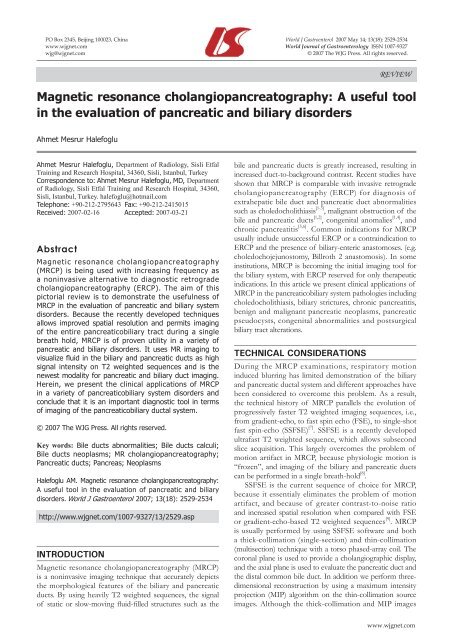18 - World Journal of Gastroenterology
18 - World Journal of Gastroenterology
18 - World Journal of Gastroenterology
Create successful ePaper yourself
Turn your PDF publications into a flip-book with our unique Google optimized e-Paper software.
PO Box 2345, Beijing 100023, China <strong>World</strong> J Gastroenterol 2007 May 14; 13(<strong>18</strong>): 2529-2534<br />
www.wjgnet.com <strong>World</strong> <strong>Journal</strong> <strong>of</strong> <strong>Gastroenterology</strong> ISSN 1007-9327<br />
wjg@wjgnet.com © 2007 The WJG Press. All rights reserved.<br />
Magnetic resonance cholangiopancreatography: A useful tool<br />
in the evaluation <strong>of</strong> pancreatic and biliary disorders<br />
Ahmet Mesrur Halefoglu<br />
Ahmet Mesrur Halefoglu, Department <strong>of</strong> Radiology, Sisli Etfal<br />
Training and Research Hospital, 34360, Sisli, Istanbul, Turkey<br />
Correspondence to: Ahmet Mesrur Halefoglu, MD, Department<br />
<strong>of</strong> Radiology, Sisli Etfal Training and Research Hospital, 34360,<br />
Sisli, Istanbul, Turkey. halefoglu@hotmail.com<br />
Telephone: +90-212-2795643 Fax: +90-212-2415015<br />
Received: 2007-02-16 Accepted: 2007-03-21<br />
Abstract<br />
Magnetic resonance cholangiopancreatography<br />
(MRCP) is being used with increasing frequency as<br />
a noninvasive alternative to diagnostic retrograde<br />
cholangiopancreatography (ERCP). The aim <strong>of</strong> this<br />
pictorial review is to demonstrate the usefulness <strong>of</strong><br />
MRCP in the evaluation <strong>of</strong> pancreatic and biliary system<br />
disorders. Because the recently developed techniques<br />
allows improved spatial resolution and permits imaging<br />
<strong>of</strong> the entire pancreaticobiliary tract during a single<br />
breath hold, MRCP is <strong>of</strong> proven utility in a variety <strong>of</strong><br />
pancreatic and biliary disorders. It uses MR imaging to<br />
visualize fluid in the biliary and pancreatic ducts as high<br />
signal intensity on T2 weighted sequences and is the<br />
newest modality for pancreatic and biliary duct imaging.<br />
Herein, we present the clinical applications <strong>of</strong> MRCP<br />
in a variety <strong>of</strong> pancreaticobiliary system disorders and<br />
conclude that it is an important diagnostic tool in terms<br />
<strong>of</strong> imaging <strong>of</strong> the pancreaticobiliary ductal system.<br />
© 2007 The WJG Press. All rights reserved.<br />
Key words: Bile ducts abnormalities; Bile ducts calculi;<br />
Bile ducts neoplasms; MR cholangiopancreatography;<br />
Pancreatic ducts; Pancreas; Neoplasms<br />
Halefoglu AM. Magnetic resonance cholangiopancreatography:<br />
A useful tool in the evaluation <strong>of</strong> pancreatic and biliary<br />
disorders. <strong>World</strong> J Gastroenterol 2007; 13(<strong>18</strong>): 2529-2534<br />
http://www.wjgnet.com/1007-9327/13/2529.asp<br />
INTRODUCTION<br />
Magnetic resonance cholangiopancreatography (MRCP)<br />
is a noninvasive imaging technique that accurately depicts<br />
the morphological features <strong>of</strong> the biliary and pancreatic<br />
ducts. By using heavily T2 weighted sequences, the signal<br />
<strong>of</strong> static or slow-moving fluid-filled structures such as the<br />
REVIEW<br />
bile and pancreatic ducts is greatly increased, resulting in<br />
increased duct-to-background contrast. Recent studies have<br />
shown that MRCP is comparable with invasive retrograde<br />
cholangiopancreatography (ERCP) for diagnosis <strong>of</strong><br />
extrahepatic bile duct and pancreatic duct abnormalities<br />
such as choledocholithiasis [1-3] , malignant obstruction <strong>of</strong> the<br />
bile and pancreatic ducts [1,2] , congenital anomalies [1,4] , and<br />
chronic pancreatitis [5,6] . Common indications for MRCP<br />
usually include unsuccessful ERCP or a contraindication to<br />
ERCP and the presence <strong>of</strong> biliary-enteric anastomoses. (e.g.<br />
choledochojejunostomy, Billroth 2 anastomosis). In some<br />
institutions, MRCP is becoming the initial imaging tool for<br />
the biliary system, with ERCP reserved for only therapeutic<br />
indications. In this article we present clinical applications <strong>of</strong><br />
MRCP in the pancreaticobiliary system pathologies including<br />
choledocholithiasis, biliary strictures, chronic pancreatitis,<br />
benign and malignant pancreatic neoplasms, pancreatic<br />
pseudocysts, congenital abnormalities and postsurgical<br />
biliary tract alterations.<br />
TECHNICAL CONSIDERATIONS<br />
During the MRCP examinations, respiratory motion<br />
induced blurring has limited demonstration <strong>of</strong> the biliary<br />
and pancreatic ductal system and different approaches have<br />
been considered to overcome this problem. As a result,<br />
the technical history <strong>of</strong> MRCP parallels the evolution <strong>of</strong><br />
progressively faster T2 weighted imaging sequences, i.e.,<br />
from gradient-echo, to fast spin echo (FSE), to single-shot<br />
fast spin-echo (SSFSE) [7] . SSFSE is a recently developed<br />
ultrafast T2 weighted sequence, which allows subsecond<br />
slice acquisition. This largely overcomes the problem <strong>of</strong><br />
motion artifact in MRCP, because physiologic motion is<br />
“frozen”, and imaging <strong>of</strong> the biliary and pancreatic ducts<br />
can be performed in a single breath-hold [8] .<br />
SSFSE is the current sequence <strong>of</strong> choice for MRCP,<br />
because it essentialy eliminates the problem <strong>of</strong> motion<br />
artifact, and because <strong>of</strong> greater contrast-to-noise ratio<br />
and increased spatial resolution when compared with FSE<br />
or gradient-echo-based T2 weighted sequences [9] . MRCP<br />
is usually performed by using SSFSE s<strong>of</strong>tware and both<br />
a thick-collimation (single-section) and thin-collimation<br />
(multisection) technique with a torso phased-array coil. The<br />
coronal plane is used to provide a cholangiographic display,<br />
and the axial plane is used to evaluate the pancreatic duct and<br />
the distal common bile duct. In addition we perform threedimensional<br />
reconstruction by using a maximum intensity<br />
projection (MIP) algorithm on the thin-collimation source<br />
images. Although the thick-collimation and MIP images<br />
www.wjgnet.com

















